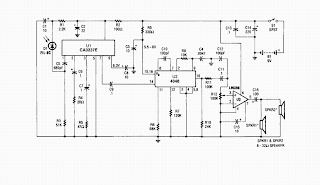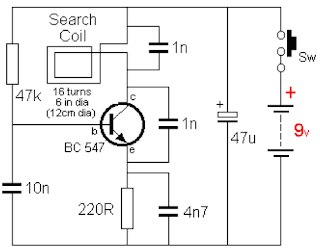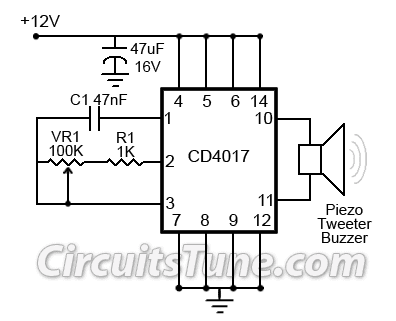Yamaha 175 Wiring Diagram and Electrical System Schematic
Yamaha 175 Wiring Color Code
| Daytime charging circuit Night time charging circuit Battery (+) circuit Ground circuit Front brake stop light Rear brake stop light Tail light Head/meter light Common circuit Headlight main circuit Headlight sub circuit Horn circuit Rectifier circuit Flasher Flasher light right Flasher light left | Green |
Wednesday, November 12, 2014
Led light bar scan back and forth led two color circuit with explanation
Operation of the circuit is divided into 3 sets.It is a set of signal generators, a set of display and control.Set the signal generator is IC1a,and IC1b number 4011 is a signal generator.The R2, R3, C2 determine the frequency generated.The signal is fed to a set of impressions is the number 4011 IC2 and IC3.The 10 counter circuits to output to the LED, and Is the same, but the work must be performed one at side.
Therefore, the signal from pin 11 of IC 2 and tested for D2 and D3,To pin 3 of IC4.The integrated circuit IC 4 is a JK flip flop is connected to a T flip flop.The signal input pin 3 and pin 1 is the output signal.Which sends a signal to the Reset IC either stop working.IC4 on the anniversary, it will output the first time, in contrast to pin1.IC3 make work, IC2 stopped.
IC2 is controlled by signals from pin 1 of IC4, to IC1c.Prior to control IC2.The IC3 is connected to pins 1 through D1 to the control again.
lm3914 led light based music circuit
This is a simple light running circuit by music This circuit is not difficult, is MONO, with a few accessories. Can be connected to the output of a CD or cassette player Time.
Operation of the circuit. Begins to be input via VR. The VR will function fine, signal strength coming. D1 will take disconnected hemisphere plus leaving only the signal hemisphere removed to activation of Q1. Signal is extended through Q1 to pin 5 input of IC1. By C1 forward delay of the IC is not the LED (connected to the output. of IC1) off immediately. The IC IC1 is finished. The act shows the effect of the voltage at IC1 pin 5 of the display by the LED to pins 1-19 of the IC, which is within range. compared to a multiple voltage standard circuits. The circuit can operate effectively. In the R1 that it will determine the current flowing through the LED. To prevent LED damage.
Use should be connected to the input of the circuit. To the speaker terminals, change the value of R3 is 10k and IC1 can choose to display two types Bar (Bar) when the pin 9 and a power source. Dots (Dot) on 9-pin to float to drop.
LM3915 Mini Audio Spectrum Analyzer
Circuit Explanation
The device is sensitive enough to determine the sound wave components of frequency and amplitude with the changing of frequency and the width of an acoustic signal. The proportionality of signal width is indicated by the brightness of LED as it turns ON while the color indicates the proportionality of frequency. In order for the red LED to turn ON in strong signal, the sensitivity of the input circuit is adjusted by resistor R2. The middle signal is represented by a yellow LED while the low signal is indicated the green LED.
Part List
R1= 1K8Kohm
R2= 100Kohm trimmer
R3= 1Kohm
R4= 100 ohm…..1Kohm
R5= 100 ohm…..1Kohm
R6= 100Kohm trimmer
C1= 100nF 100V
D1….10= RED LED
D11….20= YELLOW LED
D21….30= GREEN LED
IC1= LM3915
IC2= 4017
IC3= 4011
Application
This audio spectrum analyzer is a user interface component capable of making visible the sound pressure for a range of frequencies over time by taking a sample from an audio data stream and an animated visualization during the play is created in real time. It is ideal for any purpose which includes analysis and identification of human speech, ham radio audio reception tuning, analysis of vocal and instrumental music, evaluation and tuning of musical instruments, analysis of bat echolocation sounds, evaluation and calibration of home audio systems, and analysis and identification of biological sounds. Other uses of the audio spectrum analyzer are in distortion analysis, transfer functions, and digital filtering.
Tuesday, November 11, 2014
One second Audible Clock Circuit Schematic
The input impedance at pin #1 is very hight, so simply touching the pin (or a short track or piece of wire connected to it) is usually enough to provide the necessary input signal. Another way to provide an input signal consists in a piece of wire wrapped several times around any convenient mains cable or transformer. No other connection is necessary.
Circuit diagram:
Parts:
R1 = 10K
R2 = 47.K
R3 = 100R
C1 = 1nF-63V
C2 = 10µF-25V
C3 = 100nF-63V
D1 = 1N4148
D2 = 1N4148
D3 = 1N4148
D4 = LED-(Optional, any shape and color, see Notes)
D5 = 1N4148-75V 150mA Diode (Optional, see Notes)
Q1 = BC337-45V 800mA NPN Transistor
IC1 = 4024-7 stage ripple counter IC
BZ1 = Piezo sounder (incorporating 3KHz oscillator)
SPKR = 8 Ohm, 40 - 50mm diameter Loudspeaker (Optional, see Notes)
SW1 = SPST Toggle or Slide Switch (Optional, see Notes)
B1 = 3 to 12V Battery (See Notes)
Notes:
- To allow precise circuit operation in places where the mains supply frequency is rated at 60Hz, the circuit must be modified as follows: disconnect the Cathode of D1 from pin #11 of IC1 and connect it to pin #9. Add a further 1N4148 diode, connecting its Anode to R1 and the Cathode to pin #6 of IC1: thats all!
- The circuit will work fine with battery voltages in the 3 -12V range.
- The visual display, formed by D4 and R3 is optional. Please note that R3 value shown in the Parts list is suited to low battery voltages. If 9V or higher voltages are used, change its value to 1K.
- If a metronome-like click is needed, R2 and BZ1 must be omitted and substituted by the circuit shown enclosed in dashed lines, right-side of the diagram.
- Stand-by current drawing is negligible, so SW1 can be omitted.
Battery Juicer
Sunday, November 9, 2014
Simple Universal PIC Programmer
Circuit diagram:
Saturday, November 8, 2014
PIC Controlled Relay Driver
Another protective component on the AC line is the line filter. It minimizes the noise of the line too. The connection type determines the common or differential mode filtering. The last components in the filtering part are the unpolarized 100nF 630V capacitors. When the frequency increases, the capacitive reactance (Xc) of the capacitor decreases so it has a important role in reducing the high frequency noise effects. To increase the performance, one is connected to the input and the other one is connected to the output of the filtering part.
1 x PIC16F84A Microcontroller
1 x 220V/12V 3.6VA (or 3.2VA) PCB Type Transformer (EI 38/13.6)
1 x Line Filter (2x10mH 1:1 Transformer)
4 x 12V Relay (SPDT Type)
4 x BC141 NPN Transistor
5 x 2 Terminal PCB Terminal Block
4 x 1N4007 Diode
1 x 250V Varistor (20mm Diameter)
1 x PCB Fuse Holder
1 x 400mA Fuse
2 x 100nF/630V Unpolarized Capacitor
1 x 220uF/25V Electrolytic Capacitor
1 x 47uF/16V Electrolytic Capacitor
1 x 10uF/16V Electrolytic Capacitor
2 x 330nF/63V Unpolarized Capacitor
1 x 100nF/63V Unpolarized Capacitor
1 x 4MHz Crystal Oscillator
2 x 22pF Capacitor
1 x 18 Pin 2 Way IC Socket
4 x 820 Ohm 1/4W Resistor
1 x 1K 1/4W Resistor
1 x 4.7K 1/4W Resistor
1 x 7805 Voltage Regulator (TO220)
1 x 7812 Voltage Regulator (TO220)
1 x 1A Bridge Diode
DC Motor Control Circuit Notes

Here, S1 and S2 are normally open , push to close, press button switches. The diodes can be
red or green and are there only to indicate direction. You may need to alter the TIP31 transistors
depending on the motor being used. Remember, running under load draws more current. This
circuit was built to operate a small motor used for opening and closing a pair of curtains. As an
advantage over automatic closing and opening systems, you have control of how much, or how
little light to let into a room. The four diodes surriunding the motor, are back EMF diodes. They
are chosen to suit the motor. For a 12V motor drawing 1amp under load, I use 1N4001 diodes.
Solar Powered SLA Battery Maintenance
Friday, November 7, 2014
Playback Amplifier For Cassette Deck
Circuit diagram:
Because of the symmetrical ±12 V supply lines, the capacitor will not be charged. If a single supply is used, the initial surge when the capacitor is being charged causes a loud click in the loudspeaker and, worse, magnetizes the tape. The playback head provides an audio signal at a level of 200–500 mV. The two amplifiers raise this to line level, not linearly, but in accordance with the RIAA equalization characteristic for tape recorders. Broadly speaking, this characteristic divides the frequency range into three bands:
- Up to 50 Hz, corresponding to a time constant of 3.18 ms, the signal is highly and linearly amplified.
- Between 50 Hz and 1.326 kHz, corresponding to a time constant of 120 µs, for normal tape, or 2.274 kHz, corresponding to a time constant of 70 µs, for chromium dioxide tape, the signal is amplified at a steadily decreasing rate.
- Above 1.326 kHz or 2.274 kHz, as the case may be, the signal is slightly and linearly amplified. This characteristic is determined entirely by A1 (A1’). To make the amplifier suitable for use with chromium dioxide tape, add a double-pole switch (for stereo) to connect a 2.2 kΩ resistor in parallel with R3 (R3’). The output of A1 (A1’) is applied to a passive high-pass rumble filter, C3-R5 (C3’-R5’) with a very low cut-off frequency of 7 Hz. The components of this filter have exactly the same value as the input filter, C1-R1 (C1’-R1’). The second stage, A2 (A2’) amplifies the signal ´100, that is, to line level (1V r.m.s.).
6Volt Doorbell Light Circuit
9 Volt 2 Ampere DC Power Supply Circuit Diagram
C2 = 10uF-25V electrolytic capacitor, at least 6-16V voltage rating
C3 = 100nF-63V ceramic or polyester capacitor
IC = 7809 Positive Voltage Regulator IC
D1 = 1N5400 Diode
Thursday, November 6, 2014
Converter Circuit 240V AC TO 5VDC POWER SUPPLY used 7805 Regulator
This is simple way to power some 5v logic from a 240v ac source. If a 120v ac power adapter is used, the circuit will also work for 120v ac power lines.
3V Sweeping Siren Alarm

The circuit uses a LTC1799 precision frequency generator from Linear Technology. A 74HC14 hex Schmitt trigger from Texas Instruments is also used to perform several other functions. One section is wired as a simple 7Hz square wave oscillator. The triangle waveform across that capacitor generates the low frequency sweeping signal for the siren. Two resistors bias the LTC1799 for a center frequency of about 2KHz. A flyback DC to DC converter circuit, produces a 40v peak signal, which is turned on and off according to the output of the LTC1799.
The output is connected to a quality piezoelectric beeper, which has a resonant frequency of about 2.5KHz. The result is a siren which is quite loud but draws only 40ma from a 3v supply. A piezoelectric device from Kobitone, part number 254-PB515-ROX, (Mouser part number 245-PB516) shown above works well. If you want something much smaller, although not quite as loud, try the Murata PKM17EPP-2002-BO shown above (Digikey part number 490-4688).Click on Schematic below to view PDF version of this Circuit

Wednesday, November 5, 2014
Automatic TV Lighting Switch

10 Band Equalizer
Motorcycle Battery Monitor

The heart of the circuit is IC2, a dual comparator. The comparator circuit is built without using any feedback resistors, with the indication being stabilised by capacitors C4 and C5 instead of hysteresis. Small 10-µF tantalum capacitors work well here; 220-µF ‘standard’ electrolytic capacitors are only necessary with poorly regulated generators. Voltage regulator IC1 provides the reference voltage for IC2 via voltage divider R2/R3. The onboard voltage is compared with the reference voltage via voltage dividers R4 /R5 and R6/R7, which are connected to the inverting and non-inverting comparator sections, respectively.

Using separate dividers allows the threshold levels to be easily modified by adjusting the values of the lower resistors. IC2a drives the anode of the red diode of LED D4 via pull-up resistor R10. The anode of the green diode is driven by IC2b and R11. T2 pulls R11 to ground, thereby diverting the operating current of the green diode of the LED, if the voltage of the electrical system exceeds a threshold level of 15 V (provided by Zener diode D3). The paralleled gate outputs on pins 10 and 11 of IC3 perform a similar task. However, these gates have internal current limiting, so they can only divert a portion of the current from the red diode of the LED.
The amount of current diverted depends on the battery voltage. The two gates are driven by an oscillator built around IC3a, which is enabled via voltage divider R14/R15 and transistor T1 when the battery voltage is sufficiently high. Depending on the state of IC3a, the red diode of the LED blinks or pulses.
The circuit is connected to the electrical system via fuse F1 and a low-pass filter formed by L1 and C1. If you cannot obtain a low-resistance choke, a 1-Ω resistor can be used instead. In this case, the values of C3, C4 and C5 should be increased some-what, in order to help stabilise the indication. D1 protects the circuit against negative voltage spikes, as well as offering protection against reverse-polarity connection. Due to its low current consumption (less than 30 mA), the circuit could be connected directly to the battery, but it is better to power it from the switched positive voltage.
Pc Temperature Alarm
Pc Temperature Alarm Circuit Diagram
Fig. 1 shows the circuit of the PC temperature alarm and Fig. 2 shows the pin configuration of sensor LM35. IC LM35 (IC1) is an easy-to-use temperature sensor. It is basically a three-terminal device (two supply leads plus the output) that operates over a wide supply range of 4 to 20V. It consumes only 56 µA at 5V and generates insignificant heat.
IC2 is an operational amplifier used here as a voltage comparator. VR1 pro- vides a reference voltage that can be set anywhere from 0V to approximately 1V, which matches the output voltage range of IC1. This reference voltage is applied to the inverting in- put of IC2 and the output of IC1 is coupled to the non-inverting input. Consequently, the output of IC2 is low if the output of IC1 is below the reference voltage, or high if the output of IC1 exceeds the reference voltage.
Pin details of LM35
















